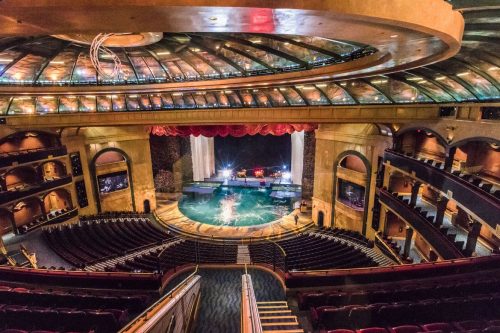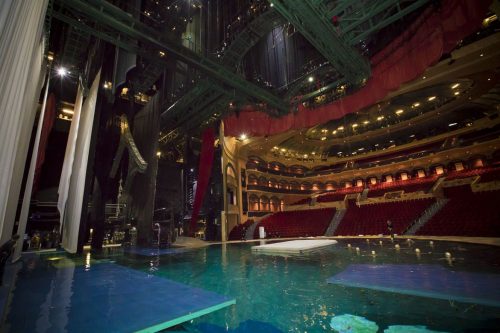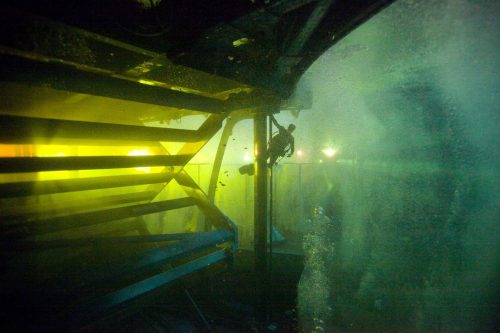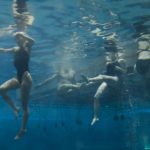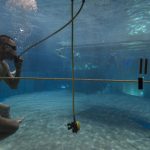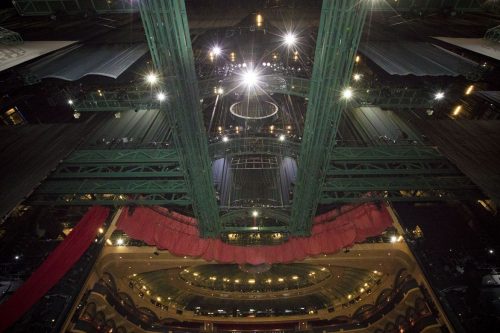There’s something eerie about seeing 1.5 million gallons of water up close.
I’m standing in the dark — 17 feet underground — pressed up against a massive tank while swimmers and divers glide in and out of view.
Down here, I feel a long way from the noisy Las Vegas strip.
This tank is arguably one of the most famous attractions in Vegas. Ten times a week for the last 18 years, swimmers, acrobats, high divers and contortionists have been diving into this water and skating across its surface as part of Cirque du Soleil’s water-themed show, “O.”
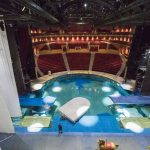
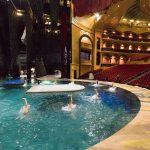
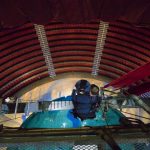
As a mad theatre nerd, this show is my Xanadu (the place, not the theatrical production). But going behind the scenes I could see just how much work and technological wizardry goes into putting this show on every night. From the hydraulic stage that drops away to reveal a 17-foot deep pool to the countless set pieces that move around high above stage, all automated to within a fraction of a second, “O” is a technical marvel.
DISAPPEARING ACT
Before “O” opened to the public in October 1998, Cirque du Soleil was already well known for its epic productions and unique staging. But the construction of the Bellagio casino in Las Vegas in the late ’90s presented a new opportunity: a custom-built theatre and a blank slate.
So what do you do when you build in Vegas? You start with a pool, of course. And if you’re going to do a water show, why not do it with a 1.5 million gallon tank?
Even with all this water — “O” takes its name from the French word for water, “eau” — Cirque still needed a stage. But unless Cirque wanted to build a pirate ship (and Vegas already had plenty of steamy, pirate-themed shows of varying quality), it needed something better than wood.
The “O” stage is made of Mondo flooring (the kind you find at track meets) and is actually separated into four parts, each set atop four massive scissor lifts. The lifts can quickly and smoothly drop from inches above water to the bottom of the pool 17 feet below, deep enough for a high diver to jump in from 60 feet in the air.
In the bowels of the theatre, it all seems so effortless as this hulking stage slips down into the pool, water passing through thousands of holes drilled across the surface.
Sitting in the audience, the effect is mesmerising: Clowns walk on solid ground one minute, and the next, an acrobat is seemingly walking on water or a high diver is disappearing into the blue.
While a dive from 60 feet is death defying enough, it’s hard to imagine how Cirque could have created any more challenges with the staging of the show.
But backstage, safety is everywhere you look. You can even hear it, underneath the theatre on the dry side of the tank — a beeping sound, like sonar, that signals the stage is moving and warns stray divers to get out of the pool. With 18 years under its belt, it’s clear that Cirque leaves nothing to chance.
BENEATH THE SURFACE
Watching the “O” team in action is a theatre buff’s dream. Techies harnessed 110 feet above the stage rig high wires and set up ladders for high divers. Swimmers flit backstage to make their next cue. Safety divers wait in the pool behind the curtains, looking like stagehands but in scuba gear.
The cast and crew numbers are huge. There are 75 performers and another 122 technicians who work behind the scenes. Every person in the crew (except the 27-person team in wardrobe) is a certified scuba diver.
Fourteen of the divers stay in the water during the entire show, doing normal backstage duties like moving props and keeping performers alive.
If you’ve seen “O,” you’ll remember the bevy of synchronised swimmers who open the show, performing an intricate and perfectly timed routine using nothing but their feet to dip in and out of the water.
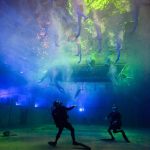
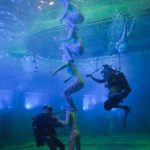
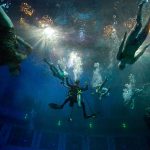
These swimmers spend roughly 90 seconds underwater, but even the Olympic swimmers in the cast can’t stay under for that long. So the divers are on hand in the pool with a massive labyrinth of air hoses and regulators for each performer, keeping them breathing safely underwater and maintaining the illusion on the surface.
The music from the show’s live 10-piece band plays through underwater speakers so performers can keep time underwater, while two of the divers also wear full face masks so they can maintain constant communication with the lighting booth at the very top of the theatre.
As a result, the performers above and below the water are in perfect unison, while the divers can talk from inside the pool with the techies sitting in the rafters.
You won’t find that in “Hamilton.”
TOTAL CONTROL
Going behind the scenes, you get a sense of just how many moving parts there are in “O.” With 75 performers hanging from aerial hoops, swinging metal frames and giant carousel horses, Cirque has its hands full with staging, cues and technical requirements.
Add in the fact that performers have come and gone during the 18-year run and that each new performer needs to slot into the show without skipping a beat, it makes sense for every element of this complicated performance to be automated.
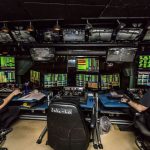
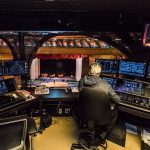
The entire show is run through two automation consoles in the lighting booth that control virtually every element of the production apart from the performers themselves.
The moving stage and set, the lighting cues, the rotating mechanical carousel that supports the aerial performers high above the stage and the piano that sinks below the water at the end of the show — all these elements are viewed on a series of screens in the lighting booth.
Combined with cameras that give the crew multiple views of the backstage areas, the whole setup is kind of like a high-tech Bond lair, rather than a theatre. It’s certainly a long way from the lighting booth at your local amateur rep.
But we’d expect nothing less from one of the biggest touring production companies in the world.
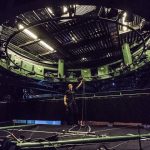
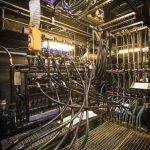
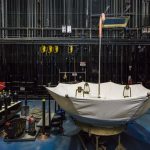
I remember watching “O” many years ago on my first trip to Vegas. Even in the good seats that I somehow snagged up front, none of the hard work behind the show was visible. I didn’t see the crew watching over the high divers from 110 feet. I didn’t see the safety divers on standby to give a breath of air underwater. I didn’t see the giant automated carousel that spirited carousel horses in from above, or the wardrobe team busy at work deep under the stage, getting the performers ready for the show.
All I saw were perfectly synchronised feet flitting around above the water. But that’s the perfect magic trick: a touch of misdirection and an effortless reveal, all hiding the hard work going on behind the scenes.
{ SOURCE: C-NET | https://goo.gl/q5ljnS }
